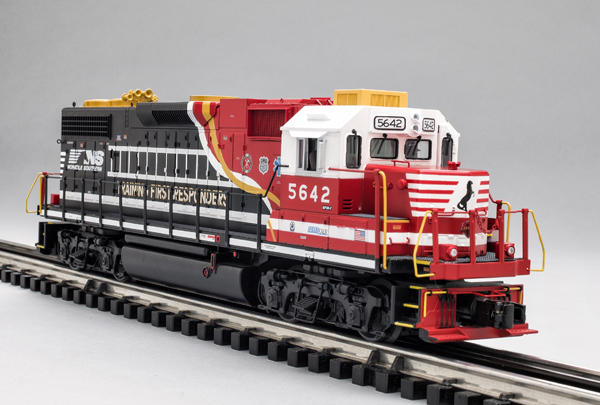O gauge GP38-2 diesel from MTH
Price: $499.95 (no. 20648-1) Min Curve: O-31 Cmd Low: 3.63 smph Cnv Low: 3.86 smph High: 66.1 smph Drawbar pull: 1 lb., 9 oz. Features: Two can-style motors, ProtoSound 3.0 command and sound system, smoke unit Current-production road names: Canadian Pacific; Detroit, Toledo & Ironton; Family Lines (Seaboard); New York Container Terminal; Norfolk Southern (First Responders)

The GP38-2 is a basic, utilitarian locomotive – a 2,000-horsepower diesel packaged in one of many similar carbody designs outshopped from EMD. Externally, it differs little from its predecessor, the GP38 (700 units sold). More than 2,200 of the -2 versions were sold to North American railways between 1972 and 1986. They are as solid and reliable a product as you can find in the railroad world.
In fact, back in 1982, Trains magazine proclaimed Baltimore & Ohio GP38 No. 3802 the All-American locomotive – the most typical representative of the country’s diesel fleet at the time.
As near as I can calculate, least 40 railroads, museums, and other rail or industrial operations still use GP38-2s in regular service, thanks to the locomotive’s reliability. The GP38-2 may be perceived as the GP9 of the second generation of American diesel power.
Norfolk Southern has certainly embraced the notion of good will through good publicity and has actively participated in events ranging from operations of its J-class Northern no. 611, to salutes to EMD cab units, and veterans.
One such commemoration was repainting Norfolk Southern GP38-2 No. 5642 in a livery honoring first responders. While the term, “first responders,” has been in use for many years, I don’t believe the term would carry the weight it does now if not for September 11th. The world could see the heroism and dedication to duty of New York City police, fire fighters, paramedics, and transit police in the face of an unprecedented tragedy. It reminded many Americans that the men and women in public safety roles, whether in large cities or small towns, are the first to step up in a crisis.
If you see No. 5642 roll past and note the emergency services livery, you may well think, “Yeah, my team!” Rarely can the public get a warm feeling while being stopped at a grade crossing.
The railroad assigned 5642 to pulling the line’s safety train, which traverses the system and is used to train emergency responders how to tackle emergency situations on the railroad. Well done, Norfolk Southern.
Opening the box
The general outline of this colorful GP38-2 from MTH looks terrific. The design of the carbody (thanks Electro-Motive) is functional and efficient, but it is also a great canvas for presenting as simple or as complex a livery as a railroad may choose. The eccentric (not in a bad way) “Training First Responders” paint scheme draws attention to many of the most interesting detail points of the locomotive.
The “Red Zone” runs from the pilot back about halfway along the body. The face of the pilot is red and has red brakeman’s steps and a red uncoupler arm with yellow handles. There is also the usual mix of air and command cables.
The deck has a black safety tread pattern, and there are two ditch lights mounted on the front deck. Steps on the pilot and leading to the cab are accented with yellow.
The handrails are red with yellow accents on the sections where crew members would hoist themselves up.
The nose is red with white stripes, and the upper part of the cab is white for getting maximum attention! Each of the four forward windows has a wiper arm, including the door window.
The headlights are in the center of the roof, and there are illuminated number boards to either side. The yellow air conditioner topside is a nice extra color element that may catch an inattentive motorist’s eye as he or she approaches a grade crossing.
The red runs behind the cab, arcing upward to reveal detailing on the see-through screens behind the cab as well as hinge and door detailing. The divider between the red and the black segments consists of two streamers of goldenrod and white that seem to be draped over the body.
The black zone has some very busy decoration. The aforementioned training slogan is below a white painted ladder whose placement accents some of the door detailing.
The Norfolk Southern logo is squeezed in at the rear, almost contacting the white stripes wrapped around the end of the long hood.
The rear mirrors the front, being red with white stripes. There is a row of grab irons for crew access leading to the roof. There is a backup light/headlight on the body, and ditch lights appear on the deck.
The busy livery includes icons representing law enforcement, fire, and emergency medical services. There were a number of warning signs, and labels scattered around the locomotive. All were readable.
On the test track
Startup sounds of the O gauge road diesel were terrific and smile inducing. The locomotive ran smoothly in all speed ranges, and the sounds kept up with it by revving up or shutting down. Bells and whistles sounded good, and a check of option functions had all working on command.
The speed range was good, ranging from 3.6 to 66.1 scale miles per hour.
The output of the smoke unit was intense, and the lighting package of headlight and ditch lights was great when viewed from track level.
MTH’s model of the GP38-2 itself is a great rendering that can be classified an All American, just as B&O no. 3802 was. It is typical in detailing, speed, pulling power, sounds, and command functions of the better O gauge locomotives of the Digital Era. The First Responder graphics make this an interesting model to add to your fleet, and the operational qualities won’t disappoint you.













